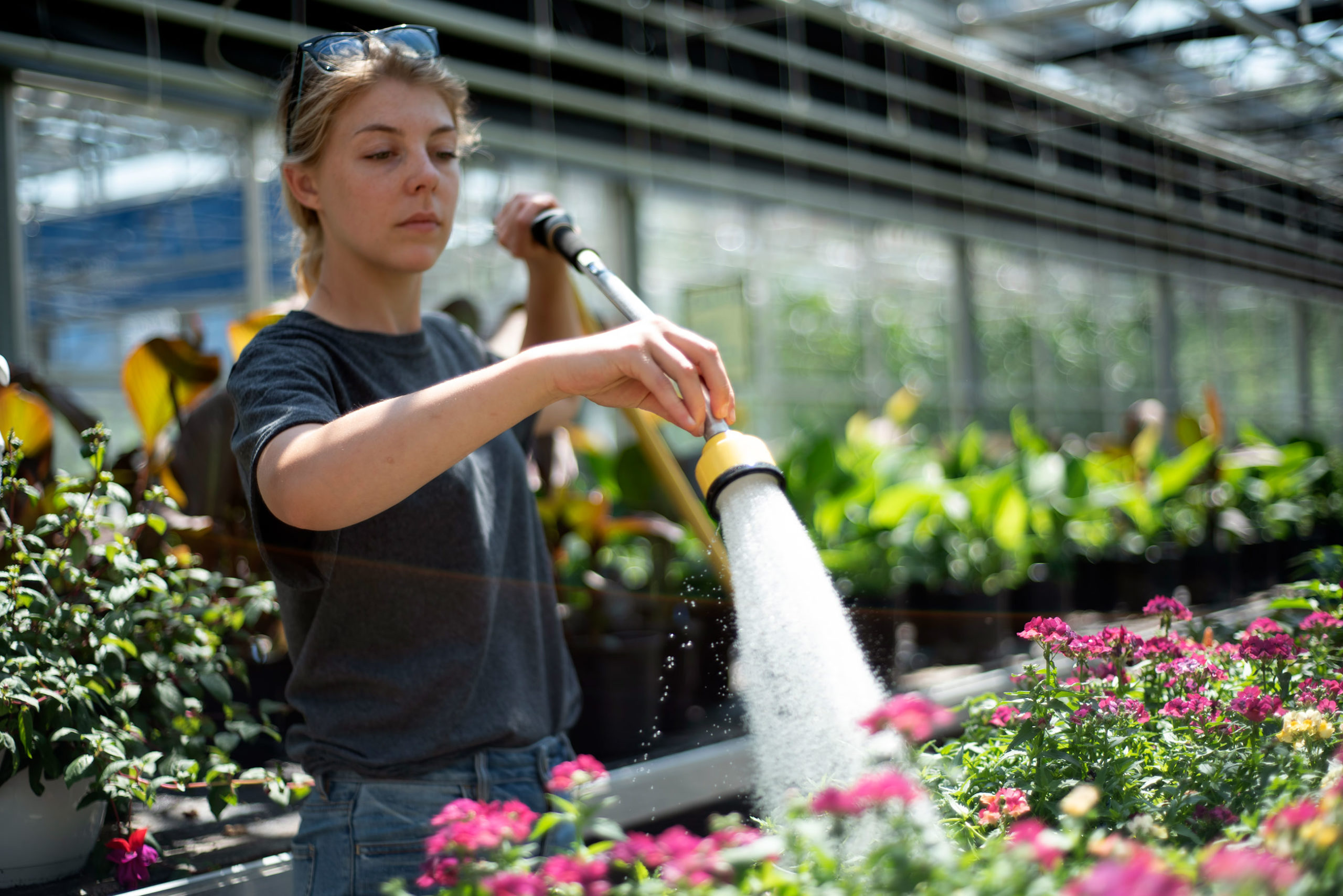Home>Gardening News and Trends>What Are The Major Greenhouse Gases?


Gardening News and Trends
What Are The Major Greenhouse Gases?
Modified: January 22, 2024
Discover the latest news on major greenhouse gases and gain insights into their impact on the environment. Stay informed about the latest developments in the world of environmental sustainability.
(Many of the links in this article redirect to a specific reviewed product. Your purchase of these products through affiliate links helps to generate commission for Chicagolandgardening.com, at no extra cost. Learn more)
Table of Contents
Introduction
Understanding the major greenhouse gases is essential in comprehending the impact of human activities on the Earth’s climate. These gases, which include carbon dioxide (CO2), methane (CH4), nitrous oxide (N2O), and fluorinated gases, play a significant role in trapping heat in the atmosphere, leading to global warming and climate change.
Human activities, such as burning fossil fuels, deforestation, and industrial processes, have significantly increased the levels of greenhouse gases in the atmosphere. As a result, the Earth’s temperature has been rising, causing extreme weather events, melting ice caps, and rising sea levels.
Each greenhouse gas has different characteristics and sources. Understanding their properties and sources is crucial in developing effective strategies to mitigate climate change and reduce greenhouse gas emissions.
In this article, we will explore the major greenhouse gases in detail, including their properties, sources, and impact on the environment. By gaining a better understanding of these gases, we can work towards a more sustainable future and take necessary actions to reduce our carbon footprint.
Carbon Dioxide (CO2)
Carbon dioxide (CO2) is the most well-known and abundant greenhouse gas, accounting for approximately 82% of all greenhouse gas emissions. It is released into the atmosphere through both natural processes and human activities.
Natural sources of carbon dioxide include volcanic eruptions, respiration by plants and animals, and the decay of organic matter. However, human activities are primarily responsible for the significant increase in CO2 levels in the atmosphere over the past century. The burning of fossil fuels such as coal, oil, and natural gas for energy production is the largest contributor to CO2 emissions. Deforestation, which reduces the Earth’s capacity to absorb CO2 through forests, also plays a significant role.
Carbon dioxide has the ability to trap heat in the atmosphere, leading to the greenhouse effect. This warming effect is essential for life on Earth. However, excessive CO2 emissions can disrupt the natural balance, causing the Earth’s temperature to rise at an alarming rate. The consequences of increased CO2 levels include rising global temperatures, melting ice caps, and more frequent and severe weather events such as heatwaves, droughts, and hurricanes.
Efforts to mitigate CO2 emissions include transitioning to renewable energy sources, improving energy efficiency, and promoting sustainable land use practices. Additionally, carbon capture and storage technologies aim to capture CO2 emissions from power plants and industrial facilities and store them underground to prevent their release into the atmosphere.
It is crucial to reduce our reliance on fossil fuels, promote sustainable transportation, and actively engage in reforestation efforts to absorb and store excess CO2. Recognizing the impact of carbon dioxide and taking decisive action is key to curbing the effects of climate change and ensuring a sustainable future for generations to come.
Methane (CH4)
Methane (CH4) is another significant greenhouse gas that contributes to global warming. Although it is present in smaller quantities compared to carbon dioxide, methane is approximately 25 times more potent in trapping heat in the atmosphere over a 100-year period.
There are both natural and human-driven sources of methane emissions. Natural sources include wetlands, termites, and the digestive systems of ruminant animals like cows and sheep. However, human activities are a major driver of increased methane emissions. Agriculture, particularly livestock farming and rice cultivation, is a significant source of methane. Additionally, methane is released during the extraction, production, and transport of coal, oil, and natural gas. Waste management, including the decomposition of organic waste in landfills, is also a substantial source of methane emissions.
The impact of methane on climate change extends beyond its warming potential. When methane reacts with other pollutants in the atmosphere, it can contribute to the formation of ground-level ozone, a harmful air pollutant. Ground-level ozone has detrimental effects on human health, leading to respiratory issues and other respiratory-related illnesses.
To reduce methane emissions, it is crucial to implement practices such as improved livestock management, including changes in animal diet and waste management systems. In the energy sector, efforts to reduce methane leakage during extraction and transportation of fossil fuels are critical. Additionally, methane capture and utilization technologies can help minimize methane emissions from waste management facilities.
Addressing methane emissions is an essential component of global climate action. By implementing strategies to reduce methane, we can significantly contribute to mitigating climate change and improving air quality, leading to a more sustainable and healthier environment.
Nitrous Oxide (N2O)
Nitrous oxide (N2O), also known as laughing gas, is a potent greenhouse gas that contributes to climate change and ozone depletion. While it is present in smaller quantities compared to carbon dioxide and methane, nitrous oxide has a significantly greater warming potential than both of these gases.
Nitrous oxide is released into the atmosphere through both natural and human activities. Natural sources include microbial processes in soils and oceans, as well as the breakdown of nitrogen-containing compounds in the atmosphere during lightning strikes. Human activities, however, are the primary driver of increased nitrous oxide emissions. Agricultural practices, such as the use of nitrogen-based fertilizers, contribute significantly to nitrous oxide emissions. Additionally, the combustion of fossil fuels and the operation of certain industrial processes, such as the production of nylon and nitric acid, also release nitrous oxide into the atmosphere.
Nitrous oxide has a long atmospheric lifetime, which allows it to spread globally and contribute to climate change. It not only has a warming effect but also plays a role in the depletion of the ozone layer. The depletion of ozone allows more harmful ultraviolet (UV) radiation from the sun to reach the Earth’s surface, which can have adverse effects on human health and ecosystems.
To tackle nitrous oxide emissions, it is essential to implement sustainable agricultural practices that optimize the use of fertilizers and reduce nitrogen loss from agricultural systems. This includes precision application techniques and using nitrogen-fixing crops to minimize the need for synthetic fertilizers. In industrial processes, the adoption of cleaner and more efficient production methods can help reduce nitrous oxide emissions.
Addressing nitrous oxide emissions is crucial for mitigating climate change and preserving the ozone layer. By taking proactive measures to reduce nitrous oxide emissions, we can minimize the impacts on the environment, human health, and global climate stability.
Fluorinated Gases
Fluorinated gases, often referred to as F-gases, are a group of synthetic greenhouse gases that are mainly used in industrial applications. Although they exist in much smaller quantities compared to carbon dioxide and methane, fluorinated gases have a significant impact on global warming due to their extremely high potency and long atmospheric lifetimes.
There are several types of fluorinated gases, including hydrofluorocarbons (HFCs), perfluorocarbons (PFCs), and sulfur hexafluoride (SF6). HFCs are commonly used in refrigeration, air conditioning, and foam-blowing applications. PFCs are primarily used in the semiconductor industry and as an insulator in high-voltage electrical equipment. SF6 is mostly used in the electrical industry as a dielectric gas in power switches and transformers.
The main driver of fluorinated gas emissions is their use in various industrial processes. These gases have extremely potent warming potentials, ranging from hundreds to thousands of times more powerful than carbon dioxide. Their long atmospheric lifetimes can contribute to the accumulation of heat-trapping gases in the atmosphere over time.
In recent years, there have been concerted efforts to reduce the consumption and emission of fluorinated gases. The Kigali Amendment to the Montreal Protocol aims to phase down the production and use of HFCs, which are among the most widely used fluorinated gases. The amendment provides a framework for the gradual transition to more environmentally friendly alternatives, such as low-global-warming-potential refrigerants.
Reducing fluorinated gas emissions requires replacing them with less harmful alternatives and implementing more efficient technologies. The development and adoption of climate-friendly technologies, along with improved equipment maintenance and leak detection, are crucial in minimizing the release of fluorinated gases into the atmosphere.
Addressing the issue of fluorinated gases is an important step towards mitigating climate change and protecting the environment. By transitioning to more sustainable alternatives and reducing the use of these potent greenhouse gases, we can contribute to a more sustainable future with lower global warming potential and reduced impact on the climate.
Conclusion
Understanding the major greenhouse gases, including carbon dioxide, methane, nitrous oxide, and fluorinated gases, is crucial in addressing and mitigating climate change. These gases play a significant role in trapping heat in the Earth’s atmosphere, leading to global warming and environmental disruptions.
Carbon dioxide, the most prominent greenhouse gas, is primarily emitted through human activities such as burning fossil fuels and deforestation. Methane, although present in smaller quantities, is highly potent and released through agricultural practices, fossil fuel extraction, and waste management. Nitrous oxide, another potent greenhouse gas, is mainly emitted from agricultural activities and industrial processes. Fluorinated gases, synthetic greenhouse gases with high warming potentials, are used in various industrial applications and contribute to global warming.
To combat the effects of these greenhouse gases, it is crucial to implement strategies that reduce emissions. Transitioning to renewable energy sources, improving energy efficiency, adopting sustainable agricultural practices, and phasing out the use of potent fluorinated gases are all vital steps in mitigating climate change.
Furthermore, awareness and individual actions are key to reducing greenhouse gas emissions. By making sustainable choices in our daily lives, such as using public transportation, conserving energy, and supporting eco-friendly products and practices, we can contribute to a greener and more sustainable future.
Addressing the major greenhouse gases requires a multi-faceted approach involving governments, industries, and individuals. With concerted efforts and collective action, we can make a significant impact in reducing greenhouse gas emissions, preserving the environment, and ensuring a sustainable future for generations to come.





